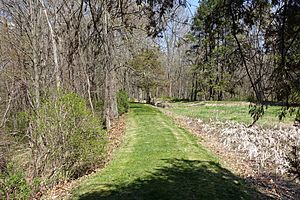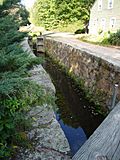Farmington Canal facts for kids
Quick facts for kids |
|
|
Farmington Canal-New Haven and Northampton Canal
|
|
 |
|
| Location | New Haven, Connecticut to Northampton, Massachusetts |
|---|---|
| Area | 247.6 acres (100.2 ha) |
| Built | 1829 |
| Architect | Hurd, Davis; Farnam, Henry |
| NRHP reference No. | 85002664 |
| Added to NRHP | September 12, 1985 |
The Farmington Canal, also known as the New Haven and Northampton Canal, was a big waterway built in the early 1800s. Its main goal was to help transport goods by boat from New Haven deep into Connecticut and Massachusetts. Part of it in Massachusetts was called the Hampshire and Hampden Canal.
When railroads became popular, the canal quickly changed into a railway. After many years, the railway was no longer used. Today, much of the old canal path has been turned into a fun multi-use trail. This project is often called a "rails-to-trails" project.
The entire path of the canal in Connecticut is considered historically important. It was added to the National Register of Historic Places in 1985. This area covers about 247 acres and includes many old bridges, aqueducts, and other structures. Two specific parts, the Farmington Canal Lock in Cheshire and Lock No. 13 in Hamden, were listed separately even earlier. These are two of the 28 original locks that helped boats move up and down the canal.
Contents
Building the Canal and Railroad
From Waterway to Railway
Work on the Farmington Canal began in 1825. By 1828, the first part of the canal was open, connecting New Haven to Farmington. The full canal, reaching Northampton, was finished and ready for use by 1835.
However, the canal never made much money. Soon, railroads started to become a better way to move goods. They were faster and more reliable. Because of this competition, the canal was quickly replaced. In 1848, the New Haven and Northampton Company built a railroad right along the canal's path.
A person named Joseph Earl Sheffield helped pay for both the canal and the railroad. This railroad later joined with a bigger company, the New York, New Haven and Hartford Railroad, in 1887. Parts of the railway were still used until the 1980s.
Important Canal Structures
The Farmington Canal Aqueduct
Building the canal had its challenges. One big problem was how to cross the Farmington River. The canal was about 50 feet higher than the river, so they couldn't just merge. To solve this, they built a special bridge for the water, called an aqueduct.
This aqueduct was 280 feet long and had seven arches, each 40 feet apart. The stone pillars that held it up were a landmark for many years. Sadly, a big flood in 1955 badly damaged them. They had to be removed a few years later. Today, the remains of the aqueduct are protected by the Farmington Land Trust.
The Whitings Basin
The Whitings basin was a busy spot in Plainville, Connecticut. It was located between Whiting Street and West Main Street. Edna Whiting owned a general store right next to the canal. Her store had doors that opened directly to the canal, making it easy for boats to drop off goods.
The store sold many things like jelly, spices, and grains. Important items like the original clock weights for Eli Terry's famous pillar and scroll clocks also passed through this basin.
Canal Locks
Locks were like water elevators that helped boats move up or down different water levels in the canal. The Farmington Canal had 28 locks in total.
Most of the early locks (1-8) have been taken down. Lock 12 has been restored and looks like it could work, with movable gates. However, it doesn't actually function as a lock today because there isn't enough water to fill it properly. The house where the lock keeper lived at Lock 12 has also been restored.
Lock 13 is still there but is hidden in the woods and covered by plants. The lock keeper's house for Lock 13 is gone, but you can still see its old foundation and well. Lock 14 is also recognizable, but its walls have fallen apart, and it's dry inside. The lock keeper's house for Lock 14 is still standing, and there are plans to use it for town services.
The Farmington Canal Trail
In the 1990s, the old railroad path was transformed into a rail trail. This trail is now used for walking, biking, and other fun outdoor activities. The Farmington Canal Trail stretches all the way from downtown New Haven to Northampton, Massachusetts. It follows very closely to the path of Route 10.
Images for kids




